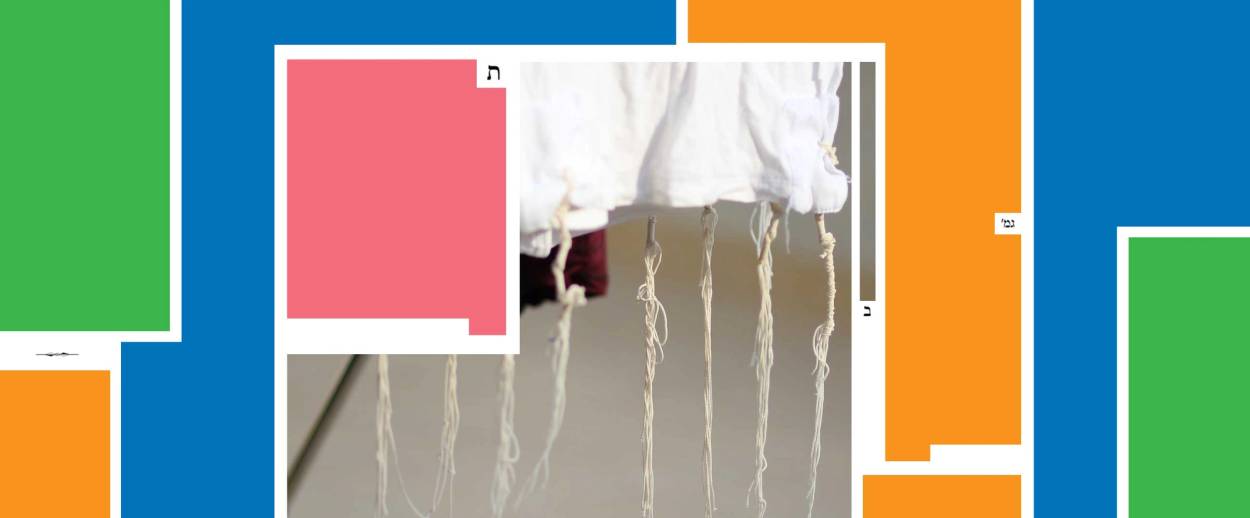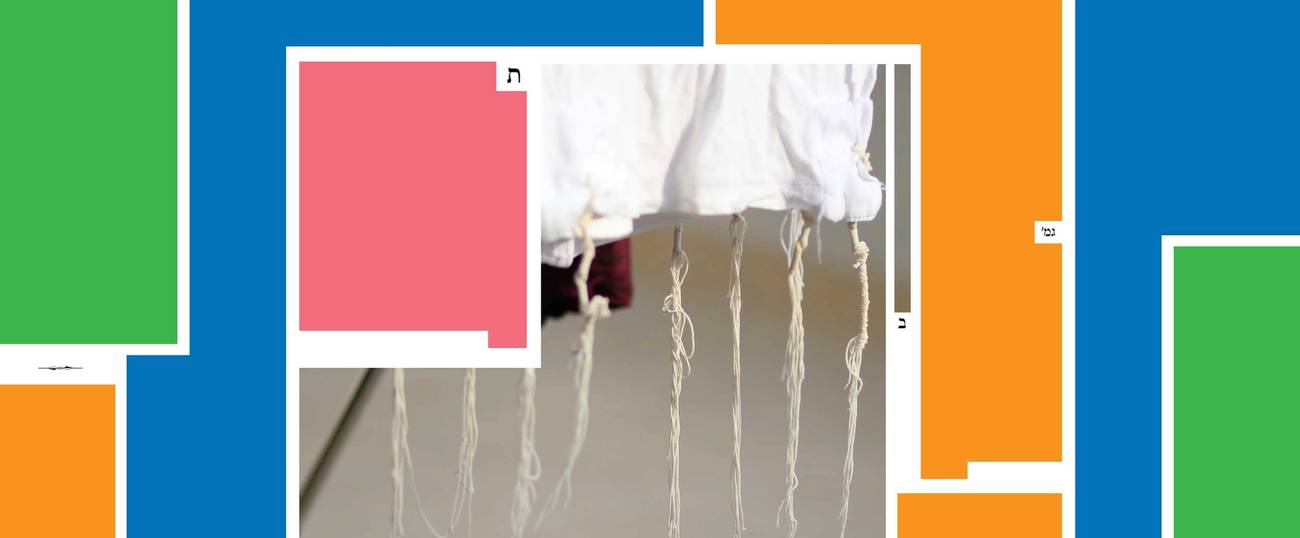Strings Attached
In this week’s ‘Daf Yomi’ Talmud study, two schools of biblical thought diverge over the ritual clothing fringes. Plus: Does a dead man get to wear tzitzit?




Literary critic Adam Kirsch is reading a page of Talmud a day, along with Jews around the world.
Over the last weeks of fall holidays, Daf Yomi readers continued to explore Tractate Menachot, which is devoted to the meal offerings sacrificed in the Temple. But as usually happens in the Talmud, long digressions carried us far from the nominal subject. Much of chapters three and four is devoted to the preparation of ritual objects, such as Torah scrolls, mezuzot, and tefillin. These enter the discussion by way of a formal principle: They involve mitzvot with several interdependent parts, which must all be present if the commandment is to be followed. Thus, for instance, every letter of the inscription in a mezuzah scroll must be correct if the mezuzah is to be valid.
But there are other mitzvot whose elements are independent, so that the absence of one part does not invalidate the other parts. One example is tzitzit, the strings that Jews are commanded to affix to the corners of their garments. This is one of the oldest continuous markers of Jewish identity, since wearing fringes—unlike, for example, wearing a kippah—is a Torah commandment. In the Book of Numbers, God instructs Moses: “Speak to the Children of Israel, and command them that they prepare for themselves throughout their generations strings on the corners of their garments, and they shall put on the fringe of the corner a sky-blue thread.”
Yet here is an example of change as well as continuity, since today’s tzitzit do not include a sky-blue thread; the fringes are all white. That is because the “sky-blue” mentioned in the Torah is not simply a color, but a specific dye—tekhelet, made from a particular species called hilazon. In the ancient world, this was an expensive luxury, and at a certain point after the fall of the Roman Empire, the technique of making it was forgotten—indeed, today no one knows for sure exactly what a hilazon is. (The most likely candidate is a kind of snail.) So we are no longer able to fulfill the Torah commandment completely.
The question arises, then: Can the mitzvah of wearing tzitzit be performed in part, using white strings without blue strings? Fortunately, the mishna in Menachot 38a says yes: “The absence of the sky-blue strings does not prevent fulfillment of the mitzva of ritual fringes with the white strings, and the absence of white strings does not prevent fulfillment of the mitzva with the sky-blue strings.” It is better to use all white strings than to forgo tzitzit altogether.
But that is just the beginning of the Talmud’s many questions with regard to tzitzit. In fact, this is exactly the kind of subject that the Talmud delights in: a Biblical commandment that is delivered in such general terms that the rabbis are left with many specific details to work out. For example, the Torah says simply that Jews must wear “strings on the corners of your garments.” But how many strings? How long are they supposed to be? Presumably they must be knotted, in order to attach them to the garment—but in what manner?
All these issues are addressed in the rabbinic discussion. But the subject that engages most of the rabbis’ attention has to do with what the strings are made of. In Deuteronomy, two commandments are given side by side: “You shall not wear diverse kinds, wool and linen together. You shall prepare for yourself cords upon the four corners of your covering.” The prohibition on shaatnez, garments made of mixed wool (an animal product) and linen (a plant product), is in keeping with many other Jewish prohibitions on mixtures and hybrids—for instance, on mixing meat and milk.
But the juxtaposition of this commandment with the commandment to wear tzitzit is perplexing, because tekhelet is defined specifically as dyed wool. It would seem to follow that, whenever a Jew wears linen clothing—a necessity in those hot Near Eastern summers—he must affix a wool thread to it. But isn’t this shaatnez? How can both of these commandments be kept at the same time?
This was a subject of dispute between Beit Shammai and Beit Hillel, the two opposing schools of the Second Temple period. Beit Shammai, which usually interpreted the law strictly, believed that since tzitzit had to be made of wool, they could not be attached to linen garments, as the mixture was forbidden. Beit Hillel, on the other hand, believed that all garments required tzitzit, so that the ban on mixing linen and wool did not apply when it came to attaching wool threads to a linen cloak. And in general, the law follows the ruling of Beit Hillel. As Reish Lakish notes, this solution is consistent with the general principle that “any place where you find a positive mitzva and a prohibition that clash with one another, if you are able to fulfill both of them, that is preferable; and if that is not possible, the positive mitzva shall come and override the prohibition.”
Naturally, the rabbis also discuss the question of the proper number and length of the strings. Standard practice is to use four strings, which pass through the garment and hang down on either side, so that there are eight fringes. (In this case, unusually, we follow the practice of Beit Shammai; Beit Hillel used only three strings.) Rav Pappa says that these strings must be attached within three finger-breadths of the edge of the garment, while Rabbi Ya’akov adds that they must be attached no closer than a thumb-joint’s length from the edge.
There is also a complex system of winding and knotting involved. In each group of fringes, one string is wound around the others, creating a tassel that is secured by a knot. According to the Gemara, there must be at least seven sets of windings separated by knots, corresponding to “the seven firmaments,” and each set must be wound three times. You can increase the number of sets, but there can be no more than 13. As for the length of the strings, there is no maximum, but there is a minimum, since according to Rav Yehuda, they must hang down at least three finger-breadths beyond the wound and knotted portion.
A more theoretical question arises in Menachot 41a: Does the mitzva of tzitzit apply to human beings or to their garments? In other words, must every garment owned by a Jew have tzitzit attached, or is it only important that they are found on a garment actually being worn at the time? If the latter, can you transfer your tzitzit from one garment to another as needed? As a matter of principle, the rabbis believe it is best to have tzitzit on all your garments, for the sake of honoring the commandment completely. According to Shmuel, “garments in a box”—that is, clothes that are being stored, not worn—“are required to have ritual fringes.”
Even a burial shroud is supposed to have tzitzit, for a touching reason. Obviously, a dead person is not obligated to fulfill mitzvot, so it might seem that a shroud could be made without them. But the Gemara explains, at the time of burial, “we certainly affix ritual fringes to the shroud, because ‘Whoever mocks the poor blasphemes his Maker.’” The quotation is from Proverbs, but here it is given a twist: In the company of the living, the dead man is considered “poor,” because he is deprived of the opportunity to perform mitzvot. To emphasize this disadvantage would be equivalent to mocking him; therefore, he is allowed to have tzitzit on his shroud, to minimize the difference between the living and the dead. This insistence on sparing the honor and the feelings even of a dead person is a sign of how greatly the rabbis valued mitzvot, and how much they feared losing the chance to perform them.
***
Adam Kirsch embarked on the Daf Yomi cycle of daily Talmud study in August 2012. To catch up on the complete archive, click here.
Adam Kirsch is a poet and literary critic, whose books include The People and the Books: 18 Classics of Jewish Literature.